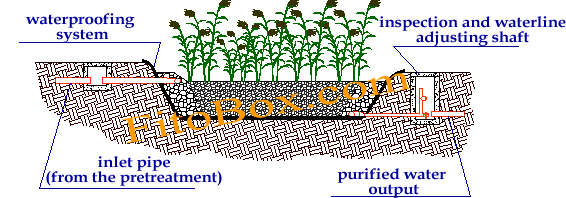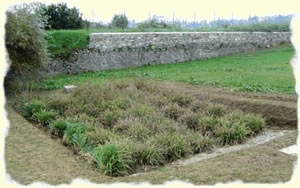![]()
Following
repeated episodes of unauthorized reproduction of our images and
text, please note that all the material contained in this site
and all trademarks belonging to Initram S.r.l. are protected by
registered patent and covered by international copyrights. No
material belonging to Initram S.r.l. may be reproduced without
written permission of the owner. Violaters will be prosecuted
to the full extent of the law. |
|
| Initram
S.r.l. owns the following trademarks |
|
| (Community Trade Mark) |
(Trade Mark and Patent) |
The reed beds (constructed wetlands) technique is a natural and extremely simple system for wastewater treatment. It consists of a waterproof basin filled with gravel and aquatic plants. The output of the system is only purified water, without any sludge production.
The purification takes place by the combined action between gravel substrate, plants and microorganisms.
The passage of the wastewater through the gravel generates microorganisms
that produce biochemical reactions of degradation of the polluting substances.
The plants have the dual role to participate directly in the removal
of pollutants and to provide the necessary oxygen to the reactions.
For this reason only the plant species that possess certain characteristics
can be used in well working constructed wetlands: in particular the
species most often used are Phragmites Australis, Carex, Juncus, Typha,
Iris.
The system works without electricity and thus of electromechanical parts. For this reason the reed bed can be defined environment friendly.
Reed beds, if appropriately dimensioned and realized, allow a reduction of the organic load of the waste water higher than 90%.

A reed bed is realized through the excavation of a basin of variable size depending on the flow rate and type of discharge. The basin is covered with a PVC sheath already provided with flanges for the insertion of the pipes to ensure hydraulic seal (patented).
Once the basin it's been waterproofed, it is filled with gravel and aquatic plants.
The level of the wastewater within the reed bed is constantly maintained 10-15 cm below the surface of the gravel using a water level control system (patented). The plant can be walked on, without surfacing water. The total absence of odors and annoying insects is guaranteed.

In order to achieve an optimal functioning of the reed bed, wastewater must be pretreated so that solids, soapy substances and other materials can be retained.
Initram S.r.l. designed and realized more than 1200 reed beds for every types of users (private houses, hotels, campings, farm holydays, vineyards, etc.) using the most tested techniques in Europe.





.gif)
.gif)
.gif)
.gif)
.gif)
.gif)
.gif)
.gif)
.gif)
.gif)
.gif)
.gif)
.gif)
